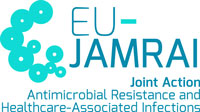Step by step guide for the implementation and assessment of Interprofessional Education (IPE)
Interprofessional Education (IPE) occurs when students or members from two or more professions learn with, from, and about each other to improve collaboration and the quality of care or outcomes. The ultimate aim of IPE is to prepare health and other professionals with the knowledge, skills, attitudes, and values necessary for effective interprofessional collaboration in practice, which is critical for addressing complex health challenges such as Antimicrobial Resistance (AMR) and implementing successful Antimicrobial Stewardship (AMS) programs from a One Health perspective.

Planning a Interprofessional Education (IPE)
The following steps should be taken into consideration when planning an Interprofessional Education strategy or training activity on AMR/AMS:
- Identify AMR/AMS Challenges Requiring an IPE Approach and Define Interprofessional Learning Objectives: Determine specific AMR/AMS issues where collaborative practice is essential for optimal outcomes (e.g., developing and implementing hospital-wide AMS programs, managing complex infections caused by multi-drug resistant organisms or MDROs, coordinating a One Health response to an AMR outbreak, improving communication about antibiotic use across primary and secondary care, or educating communities about AMR). Clearly define learning objectives that focus on developing core interprofessional competencies in the context of AMR/AMS, such as:
- Understanding and respecting the roles, responsibilities, and expertise of different professions in AMR/AMS (Roles/Responsibilities).
- Effective interprofessional communication skills for AMR-related decision-making and patient/client counseling (Interprofessional Communication).
- Teamwork, shared leadership, and collaborative problem-solving skills applied to AMR/AMS challenges (Teams and Teamwork).
- Shared values and ethics for interprofessional AMR/AMS practice (Values/Ethics). (These competencies are often based on frameworks like the Interprofessional Education Collaborative (IPEC)).
- Participant Selection and Group Composition: Intentionally bring together learners from a diverse range of relevant professions. For AMR/AMS, this should ideally include students or practitioners from medicine, pharmacy, nursing, microbiology, veterinary medicine, public health, environmental health, and potentially social sciences, agriculture, or policy, depending on the One Health scope of the IPE activity. (MacDougall et al., 2017, describe an IPE curriculum for medical and pharmacy students on AMS; Guilding et al., 2020, also involved medical and pharmacy students in an IPE conference on antimicrobial education).
- Curriculum Design Emphasizing Interactive Learning: Design IPE activities that are inherently interactive and require learners to actively learn with, from, and about each other. Passive, didactic methods where professions learn in parallel are generally less effective for developing collaborative competencies. Effective IPE methods for AMR/AMS include:
- Interprofessional simulations: (e.g., managing a simulated AMR outbreak, an AMS ward round with challenging communication scenarios).
- Case-based discussions: Analyzing complex AMR patient cases or One Health scenarios in interprofessional groups.
- Problem-based learning (PBL) with interprofessional teams.
- Shared clinical or community placements (if applicable for trainees).
- Team-based projects (e.g., developing a joint AMS protocol or an AMR awareness campaign). (Guilding et al., 2020, used small group interprofessional workshops on AMS, infection management, and patient safety).
- Skilled Interprofessional Facilitation: IPE activities should be facilitated by educators who are trained in IPE methodologies and ideally represent an interprofessional team themselves. Facilitators play a crucial role in guiding learning, managing interprofessional group dynamics, ensuring equitable participation from all professions, prompting reflection on collaborative processes, and modeling effective interprofessional behaviors.
- Creating a Supportive and Respectful Learning Environment: Establish a learning environment where participants from all professions feel psychologically safe, respected, and valued for their unique contributions and perspectives on AMR/AMS. This encourages open dialogue and willingness to learn from others.
- Logistical Planning and Institutional Support: Address practical challenges such as scheduling learners from different programs, securing appropriate learning spaces (physical or virtual), providing necessary resources, and obtaining institutional buy-in and support for IPE initiatives.

Defining roles in a Interprofessional Education (IPE)
Facilitator’s role (IPE Facilitation Team): Design and lead interactive IPE activities focused on AMR/AMS. Ensure balanced and active participation from learners representing all involved professions. Model effective interprofessional communication and collaboration. Manage interprofessional group dynamics, including addressing potential professional hierarchies or stereotypes. Guide learners to understand and appreciate the unique roles, responsibilities, and perspectives of each profession in tackling AMR. Facilitate critical reflection on both the AMR/AMS content and the interprofessional collaborative processes experienced during the learning activity.
Participant’s role (Learner from a specific profession): Actively engage with learners from other professions. Share their own professional knowledge, skills, and perspectives related to AMR/AMS clearly and respectfully. Listen attentively to and demonstrate respect for the viewpoints and expertise of other professions. Work collaboratively and constructively in interprofessional teams to address shared AMR/AMS tasks, case studies, or problems. Actively participate in reflections on how to improve interprofessional teamwork and communication in their future practice related to AMR and AMS.

Assessing a Interprofessional Education (IPE)
Methods
- Evaluation of IPE interventions should ideally assess outcomes at multiple levels (e.g., Kirkpatrick’s model), focusing on:
- Learner Reactions: Participant satisfaction with the IPE experience, perceived relevance, and quality of facilitation.
- Changes in Attitudes/Perceptions: Measuring shifts in attitudes towards interprofessional collaboration, understanding of and respect for other professions’ roles in AMR/AMS, and readiness for interprofessional learning.
- Acquisition of Knowledge and Skills: Assessing gains in knowledge about other professions’ roles in AMR/AMS, as well as development of interprofessional competencies (e.g., communication, teamwork, shared decision-making skills specific to AMR scenarios).
- Behavioral Change: Observing or self-reporting changes in learners’ collaborative behaviors in practice settings related to AMR/AMS post-IPE.
- Impact on Organizational Practice and Patient/Population Outcomes: Assessing changes in teamwork processes, adherence to AMS guidelines, or, ideally, improvements in patient safety, quality of care, or AMR-related health outcomes (e.g., reduced rates of MDRO infections, optimized antibiotic use). (Systematic reviews by Reeves et al., 2008, Reeves et al., 2013, and Reeves et al., 2016, have explored the effects of IPE on professional practice and healthcare outcomes, noting that while some positive effects are found, robust evidence directly linking IPE to patient outcomes can be challenging to establish consistently but remains the ultimate goal. Medina-Córdoba et al., 2023, found positive effects of IPE on the work environment, including job satisfaction and organizational climate).
Tools
Validated attitude scales such as the Readiness for Interprofessional Learning Scale (RIPLS) or the Interprofessional Collaborative Competency Attainment Survey (ICCAS), SPICE-R2. Behavioral observation checklists or rubrics for assessing teamwork and communication skills during simulations or group activities. Pre- and post-IPE knowledge tests on roles/responsibilities or specific AMR/AMS topics requiring interprofessional input. Reflective essays, portfolios, or debriefing session analyses. Peer assessment tools for collaborative work. Qualitative methods like focus groups or interviews with participants to explore their IPE experiences and perceived impact. Audits of clinical records for changes in AMS process measures or patient outcomes (if IPE is part of a larger quality improvement initiative).

Suggested Interprofessional Education (IPE) prototype
Target Audience: Legislators and Authorities, Health Managers, Prescribers (Doctors, Veterinarians), Dispensers (Pharmacists), Clinical Profiles (Nurses, Microbiologists), Researchers, Environmental Health Officers, Wastewater Managers, and students from these respective profession.
Learning Objectives:
- Understand and articulate the unique roles, responsibilities, and expertise of different professions (human health, animal health, environmental health, policy) in investigating and managing a complex AMR outbreak scenario from a One Health perspective.
- Develop and demonstrate effective interprofessional communication, teamwork, and shared decision-making skills under pressure during a simulated AMR crisis.
- Collaboratively analyze multifaceted data (epidemiological, microbiological, environmental, agricultural) to identify potential sources, transmission pathways, and control points for an AMR outbreak.
- Co-create a prioritized, evidence-informed, and intersectoral action plan for responding to and mitigating the simulated AMR outbreak, considering resource implications and communication strategies for diverse stakeholders.
Curriculum/Activities:
- Pre-Simulation Online Module (Optional): Learners from different professions complete a brief online module introducing core One Health principles, basic AMR epidemiology, and roles of different sectors in AMR surveillance and control.
- IPE Simulation Session (e.g., 3-4 hours):
- Team Formation: Participants are divided into small, mixed interprofessional teams.
- Scenario Introduction: Teams are presented with an unfolding, dynamic simulated AMR outbreak scenario (e.g., a novel foodborne MDRO affecting both humans and a specific livestock population, with potential environmental contamination). Information is provided in stages, requiring teams to continuously reassess and adapt their response.
- Collaborative Analysis and Planning: Teams work together to:
- Analyze incoming data (e.g., human case reports, veterinary surveillance data, food testing results, water sample analyses).
- Identify critical information gaps and prioritize further investigation.
- Discuss and agree on potential sources and transmission routes.
- Develop a coordinated intersectoral response plan, including specific interventions for human health (e.g., AMS guidelines for clinicians, public health advisories), animal health (e.g., biosecurity on farms, changes in AMU), environmental management (e.g., wastewater treatment, food safety measures), and communication strategies.
- Interspersed “Expert Consults” or “Press Briefings”: Teams may need to interact with virtual “experts” or respond to simulated media inquiries, requiring them to synthesize information and communicate clearly from a unified One Health perspective.
- Structured Debriefing (Critical Component): Following the simulation, a skilled interprofessional facilitation team leads a comprehensive debriefing session focusing on:
- The AMR/AMS content and decisions made.
- The interprofessional process: How did the team function? What were the communication successes and challenges? How were different professional perspectives integrated or overlooked? What was learned about each other’s roles and expertise? How could collaboration be improved?
Evaluation of the Prototype’s Effectiveness:
- Assessment of the quality, feasibility, and intersectoral integration of the AMR outbreak response plans developed by each team, using a pre-defined rubric.
- Observation of interprofessional teamwork and communication skills during the simulation, using a validated behavioral observation tool.
- Pre- and post-simulation surveys to measure changes in participants’ understanding of One Health principles, knowledge of different professional roles in AMR control, and attitudes towards interprofessional collaboration.
- Qualitative analysis of the debriefing sessions to identify key learning points, insights into interprofessional dynamics, and participant reflections on the value of the IPE experience for AMR preparedness.
- Participant satisfaction surveys focusing on the realism of the simulation, the effectiveness of facilitation, and the perceived impact on their ability to collaborate effectively on AMR issues.
References
- Dik, J.-W. H., Friedrich, A. W., Nathwani, D., & Sinha, B. (2017). Combating the Complex Global Challenge of Antimicrobial Resistance: What Can Antimicrobial Stewardship Contribute? Infectious Disease Reports, 9(1), 7158. https://doi.org/10.4081/idr.2017.7158
- Dyess, A. L., Brown, J. S., Brown, N. D., Flautt, K. M., & Barnes, L. J. (2019). Impact of interprofessional education on students of the health professions: A systematic review. Journal of Educational Evaluation for Health Professions, 16, 33. https://doi.org/10.3352/jeehp.2019.16.33
- Guilding, C., Hardisty, J., Randles, E., Statham, L., Green, A., Bhudia, R., Thandi, C. S., Teodorczuk, A., Scott, L., & Matthan, J. (2020). Designing and evaluating an interprofessional education conference approach to antimicrobial education. BMC Medical Education, 20, 360. https://doi.org/10.1186/s12909-020-02252-9
- Khadse, S. N., Ugemuge, S., & Singh, C. (2023). Impact of Antimicrobial Stewardship on Reducing Antimicrobial Resistance. Cureus, 15(12), e49935. https://doi.org/10.7759/cureus.49935
- Liaskos, J., Frigas, A., Antypas, K., Zikos, D., Diomidous, M., & Mantas, J. (2009). Promoting interprofessional education in health sector within the European Interprofessional Education Network. International Journal of Medical Informatics, 78(Suplemment 1), S43–S47. https://doi.org/10.1016/j.ijmedinf.2008.08.001
- MacDougall, C., Schwartz, B. S., Kim, L., Nanamori, M., Shekarchian, S., & Chin-Hong, P. V. (2017). An Interprofessional Curriculum on Antimicrobial Stewardship Improves Knowledge and Attitudes Toward Appropriate Antimicrobial Use and Collaboration. Open Forum Infectious Diseases, 4(1), ofw225. https://doi.org/10.1093/ofid/ofw225
- McEwen, S. A., & Collignon, P. J. (2018). Antimicrobial Resistance: A One Health Perspective. Microbiology Spectrum, 6(2). https://doi.org/10.1128/microbiolspec.arba-0009-2017
- Medina-Córdoba, M., Cadavid, S., Espinosa-Aranzales, A.-F., Aguía-Rojas, K., Bermúdez-Hernández, P. A., Quiroga-Torres, D.-A., & Rodríguez-Dueñas, W. R. (2023). The effect of interprofessional education on the work environment of health professionals: A scoping review. Advances in Health Sciences Education, 29(4), 1463–1480. https://doi.org/10.1007/s10459-023-10300-4
- Reeves, S., Fletcher, S., Barr, H., Birch, I., Boet, S., Davies, N., McFadyen, A., Rivera, J., & Kitto, S. (2016). A BEME systematic review of the effects of interprofessional education: BEME Guide No. 39. Medical Teacher, 38(7), 656–668. https://doi.org/10.3109/0142159x.2016.1173663
- Reeves, S., Zwarenstein, M., Goldman, J., Barr, H., Freeth, D., Hammick, M., & Koppel, I. (2008). Interprofessional education: Effects on professional practice and health care outcomes. Cochrane Database of Systematic Reviews, 1, CD002213. https://doi.org/10.1002/14651858.cd002213.pub2
- Rocha-Pereira, N., Castro Sanchez, E., & Nathwani, D. (2017). How Can Multi-Professional Education Support Better Stewardship? Infectious Disease Reports, 9(1), 6917. https://doi.org/10.4081/idr.2017.6917
- Schmid, S., Schlosser, S., Gülow, K., Pavel, V., Müller, M., & Kratzer, A. (2022). Interprofessional Collaboration between ICU Physicians, Staff Nurses, and Hospital Pharmacists Optimizes Antimicrobial Treatment and Improves Quality of Care and Economic Outcome. Antibiotics, 11(3), 381. https://doi.org/10.3390/antibiotics11030381
